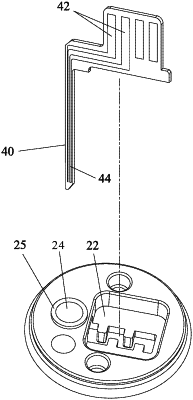| CPC A61B 5/14503 (2013.01) [A61B 5/0002 (2013.01); A61B 5/0004 (2013.01); A61B 5/14532 (2013.01); A61B 5/14546 (2013.01); A61B 5/14865 (2013.01); A61B 5/6801 (2013.01); A61B 5/688 (2013.01); A61B 5/6849 (2013.01); A61B 5/6867 (2013.01); A61B 5/1451 (2013.01); A61B 2560/045 (2013.01); A61B 2560/063 (2013.01); A61B 2562/0295 (2013.01); A61B 2562/14 (2013.01); A61B 2562/16 (2013.01); A61B 2562/166 (2013.01); A61B 2562/168 (2013.01); A61B 2562/225 (2013.01); A61B 2562/226 (2013.01); A61B 2562/227 (2013.01); H01R 12/737 (2013.01)] | 10 Claims |

|
1. A physiological signal monitoring device for at least partial implantation under a skin of a living body to measure a physiological signal of an analyte in a biological fluid from the living body, comprising:
a sensor having a signal detection end and a signal output end, wherein the signal detection end is to be implanted under the skin to detect the physiological signal, and the signal output end is to output the physiological signal;
a transmitter having a port connected to the signal output end and receiving the physiological signal, wherein the port comprises a connecting slot; and
a holder carrying thereon the sensor, wherein a top of the holder is positioned lower than a top of the signal output end, thereby the signal output end protrudes beyond the holder and is held within the connecting slot, and the holder comprising:
an implantation hole being a channel for implanting the sensor, and containing a part of the sensor;
a waterproof seal disposed above the implantation hole and abutting against the transmitter to form therebetween a waterproof sealing structure; and
an elastic divider disposed in the implantation hole to separate the implantation hole into two parts and having a cross-sectional area that is equal to or greater than a cross-sectional area of the implantation hole.
|